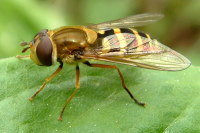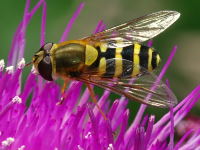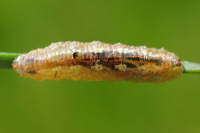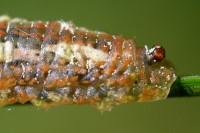Phylum Arthropoda (Arthropods) ➔ Subphylum Hexapoda (Hexapods) ➔ Class Insecta (Insects) ➔ Order Diptera (True flies) ➔ Family Syrphidae (Hoverflies)
Syrphus ribesii (Linnaeus, 1758)
Große Schwebfliege Summer Fly
Synonyms and other combinations:
Musca blandus Harris, 1780 | Musca vacua Scopoli, 1763 | Scaeva concava Say, 1823 | Syrphus autumnalis Fluke, 1954 | Syrphus beringi Violovitsh, 1975 | Syrphus bigelowi Curran, 1924 | Syrphus brevicinctus Kanervo, 1938 | Syrphus himalayanus Nayar, 1968 | Syrphus interruptus Ringdahl, 1930 | Syrphus japonicus Matsumura, 1917 | Syrphus jezoensis Matsumura, 1917 | Syrphus jonesii Fluke, 1949 | Syrphus maculifer Matsumura, 1918 | Syrphus moiwanus Matsumura, 1917 | Syrphus nigrigena Enderlein, 1938 | Syrphus philadelphicus Macquart, 1842 | Syrphus similis Jones, 1917 | Syrphus teshikaganus Matsumura, 1918 | Syrphus vittafrons Shannon, 1916 | Syrphus yamahanensis Matsumura, 1917 |
Classification:
Syrphus ribesii belongs to the subfamily Syrphinae, tribe Syrphini.Distribution:
From Iceland and Fennoscandia south to Iberia and the Mediterranean; Canary Isles; from Ireland eastwards through most of Europe into Turkey, European parts of Russia and Afghanistan; from the Urals to the Pacific coast (Kuril Isles); Japan; North America from Alaska south to central parts of the USA.Habitat:
Most types of deciduous and coniferous forest, also various open habitats.The anthropophilic species occurs in parks, gardens, orchards, horticultural land and farmland.
Description:
Body length 9 - 13 mm; abdomen with a pair of yellow spots on tergit 2 and yellow transverse bands on tergits 3 and 4; eyes bald; antennae reddish brown.Female: legs yellow, hind femora yellow. Male: hind femora at least half black at the base, with small black hairs at the apex.
Similar species:
There are some similar looking species. The most similar are Syrphus torvus and Syrphus vitripennis. Syrphus torvus has hairy eyes, in contrast to Syrphus ribesii and Syrphus vitripennis. The females of Syrphus ribesii can be distinguished from those of the similar Syrphus vitripennis by the color of the hind femora. These are 2/3 black in Syrphus vitripennis. The males are not clearly distinguishable from photos. The hind femora of male Syrphus vitripennis are 2/3...3/4 black at the base and have small yellow hairs on the apex.Biology:
The Summerfly Syrphus ribesii flies in several generations from April to November. The Imagines visit white, yellow, pink and blue flowers of a wide range of herbs, trees and shrubs. The females eat a lot of pollen, which provide the amino acids and proteins they need for egg production. The males eat pollen especially at the beginning of their adult life, because they stimulate the production of semen. Later, they switch completely to nectar, which contains high-energy sugar to cover the increased energy requirement when hovering. The males hover in 2 to 5 m height and defend their territories. The females hover too, but less frequently than the males.The polyphagous larvae of Syrphus ribesii preferentially feed on various aphid species. They pass through 3 larval stages and eat 200 to more than 750 aphids, depending on the species, size and stages of development of the prey.
The adult larvae have an optional diapause and overwinter in the litter layer.
Studies have shown that larvae are much more tolerant to low temperatures than adult hoverflies. Under laboratory conditions, the larvae of Syrphus ribesii survived temperatures of -35 ° C. In winter, warm and humid weather causes greater larval mortality than freezing cold weather.
References, further reading, links:
- Pape T. & Thompson F.C. (eds) (2017). Systema Dipterorum (version 2.0, Jan 2011). In: Species 2000 & ITIS Catalogue of Life, 2017 Annual Checklist (Roskov Y., Abucay L., Orrell T., Nicolson D., Bailly N., Kirk P.M., Bourgoin T., DeWalt R.E., Decock W., De Wever A., Nieukerken E. van, Zarucchi J., Penev L., eds.). Digital resource at www.catalogueoflife.org/annual-checklist/2017. Species 2000: Naturalis, Leiden, the Netherlands. ISSN 2405-884X.
- Gerald Bothe: Bestimmungsschlüssel für die Schwebfliegen (Diptera, Syrphidae) Deutschlands und der Niederlande, DJN, 1984, ISBN 3-923376-07-3
- M.C.D.Speight: Species Accounts of European Syrphidae (Diptera), Glasgow 2011, Syrph the Net, the database of European Syrphidae, vol. 65, 285 pp., Syrph the Net publications, Dublin.
- Menno Reemer, Willem Renema, Wouter van Steenis, Theo Zeegers, Aat Barendregt, John T. Smit, Mark P. van Veen, Jeroen van Steenis, Laurens van der Leij: De Nederlandse Zweefvliegen (Diptera: Syrphidae), Nederlandse Fauna 8, 2009.
- Graham E. Rotheray: Colour Guide to Hoverfly Larvae (Diptera, Syrphidae) in Britain and Europe, Dipterists Digest No.9, 1993, Derek Whiteley, Sheffield, England, ISSN 0853 7260
- Anasimyia interpuncta
- Anasimyia transfuga
- Baccha elongata
- Brachyopa sp.
- Brachypalpoides lentus
- Brachypalpus laphriformis
- Brachypalpus sp.
- Brachypalpus valgus
- Ceriana conopsoides
- Ceriana vespiformis
- Chalcosyrphus femoratus
- Chalcosyrphus valgus
- Cheilosia albipila
- Cheilosia albitarsis
- Cheilosia chrysocoma
- Cheilosia illustrata
- Cheilosia pagana
- Cheilosia scutellata
- Cheilosia sp.
- Chrysogaster sp.
- Chrysotoxum bicinctum
- Chrysotoxum fasciatum
- Chrysotoxum festivum
- Chrysotoxum verralli
- Criorhina berberina
- Dasysyrphus albostriatus
- Dasysyrphus sp.
- Dasysyrphus tricinctus
- Didea fasciata
- Didea intermedia
- Didea sp.
- Epistrophe diaphana
- Epistrophe eligans
- Epistrophe flava
- Epistrophe melanostoma
- Epistrophe melanostoma/nitidicollis
- Epistrophella euchroma
- Eristalinus megacephalus
- Eristalis interrupta
- Eristalis intricaria
- Eristalis lineata
- Eristalis rupium
- Eristalis similis
- Eristalis sp.
- Eumerus purpurariae
- Eumerus sp.
- Eupeodes luniger
- Eupeodes sp.
- Ferdinandea cuprea
- Helophilus hybridus
- Helophilus sp.
- Helophilus trivittatus
- Ischiodon aegyptius
- Leucozona glaucia
- Leucozona laternaria
- Leucozona lucorum
- Melangyna lasiophthalma
- Melangyna quadrimaculata
- Melangyna umbellatarum
- Melanogaster sp.
- Meligramma triangulifera
- Meliscaeva cinctella
- Merodon ambiguus
- Merodon avidus
- Merodon moenium
- Merodon obscuritarsis
- Merodon sp.
- Microdon analis/major
- Microdon mutabilis/myrmicae
- Myolepta dubia
- Orthonevra sp.
- Paragus sp.
- Parasyrphus lineolus
- Parhelophilus sp.
- Pipiza austriaca
- Pipiza bimaculata
- Pipiza fenestrata
- Pipiza sp.
- Platycheirus rosarum
- Platycheirus sp.
- Rhingia rostrata
- Scaeva albomaculata
- Scaeva selenitica
- Sericomyia lappona
- Sphaerophoria rueppelli
- Sphaerophoria sp.
- Sphegina sp.
- Spilomyia saltuum
- Syrphus sp.
- Syrphus vitripennis
- Temnostoma bombylans
- Temnostoma meridionale
- Temnostoma vespiforme
- Tropidia scita
- Xanthogramma citrofasciatum
- Xanthogramma pedissequum
- Xylota sp.
- Xylota sylvarum
- Aspen Hoverfly
- Band-eyed Drone Fly
- Black-horned Smoothtail
- Brown-toed Forest Fly
- Bumblebee Hoverfly
- Chequered Hoverfly
- Common Bog Hoverfly
- Common Drone Fly
- Common Snout-hoverfly
- Deadhead Hover Fly
- Dusky-banded Forest Fly
- European Drone Fly
- Figwort Cheilosia
- Four-spotted Pipiza
- Hornet Mimic Hoverfly
- Large Hoverfly
- Large Narcissus Fly
- Larger Spotty-eyed Drone Fly
- Long Hoverfly
- Marmalade Fly
- Migrant Hoverfly
- Orange-belted Plumehorn
- Pied Hoverfly
- Pine Hoverfly
- Snouted Duckfly
- Summer Fly
- Sun Fly
- Tapered Drone Fly
- Thick legged Hoverfly
- White-banded Drone Fly






